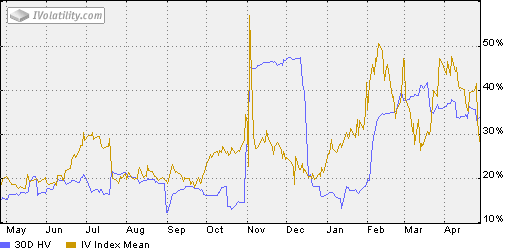Implied Volatility is metaphorically like an onion. There’s a lot of layers. Once you peel a layer, there’s another one.
Let’s start with the basics. The rest of the details come with more experience and understanding.
Simply stated, Implied Volatility is the risk component in option pricing.
Let’s take an example that you’re familiar with: car insurance. When my son turned 16, we added him to our auto insurance policy. The rate was about double that of my 40-something wife. Why is it so much higher for my son? We didn’t change our coverage limits or the cars we own.
Everyone knows the answer: risk. It’s no secret 16-year old boys get in more accidents than every other demographic of drivers.
That “risk” is also known as implied volatility. If you want to do the math, do a search on “Black Scholes Pricing Model” (I don’t recommend that unless your “nerd factor” is above 68%).
Insurance actuaries do the math based on the likelihood that teenage boys are going to get into an accident to calculate what my premium should be.
Since options are just insurance on stock, it’s the same concept.
It might be helpful to look at some real option pricing. Currently, QCOM is trading for $51.11 and USB is $51.25 – about the same price. If we take a look at the 51.5 Call which expires in 18 days for both, you’ll find the QCOM call is $1.42 and the USB is $0.77. What’s the difference? The stock prices are essentially the same. The time to expiration is identical. Both pay a dividend, but that is after this option expires. So, it is not the dividend. What explains the difference in the option pricing?
The answer is implied volatility. Just like the car insurance, people are expecting a bigger move from QCOM than USB.
Let’s flip it around. Suppose you want to sell a call on QCOM. How much do you decide to sell it for? Now, you don’t really have a choice. The market sets the price. But there is certainly some point where you’d say $X.XX is not enough and $Y.YY is too good to pass up. The price is set by people in the market making those decisions. This is because the price of the options reflects the market perception of future movement of QCOM between now and expiration, 18 days from today. That perception of future movement is implied volatility.
Let’s dive into this example a little deeper. With the 51.5 QCOM call at $1.42, that means QCOM’s breakeven price is $52.92 (the strike price + the option price.) Below that price, you make money on the call and the option buyer loses. Above that price, the option buyer makes money and you lose. (In reality, you’d probably wouldn’t sell a naked call. You would hedge with stock or other long calls.)
In the case of USB, the breakeven price is $52.27. Why is it lower for USB? It is because the market expects less movement between now and expiration. In this example, QCOM is the teenage driver.
So, how do we use implied volatility as an indicator of sentiment? The perception of risk changes. When there is an earnings event, a new product announcement, rumors of takeovers, regulatory filing, etc.. When implied volatility is high, that tells us that the market expects a bigger movement.
Consider the following chart from iVolatility.com for QCOM.
QCOM: DAILY 1 YEAR VOLATILITY CHART

You will notice that for QCOM, the IV Index Mean (gold line) is currently around 29%. It just dropped from recent highs where it was above 40% just a couple days ago. That means that while the options prices are elevated now, there were much higher, relatively speaking, just a few days ago. In this case, it was earnings that drove the implied volatility higher. Once earnings passed, the implied volatility dropped.
It looks like normal IV low after earnings is around 20%. So, there is a still some lingering sentiment of future volatility. My perspective is that it’s probably from both the market and the technology hardware sector, which has experience increased volatility lately.
You can use this gold line as a forecast of what the market expects to happen in the future. It’s not always right and sometimes teenage boys don’t get in accidents. And if my son can prove that with a safe driving record, we might qualify for a “safe driver” discount.
We didn’t.

